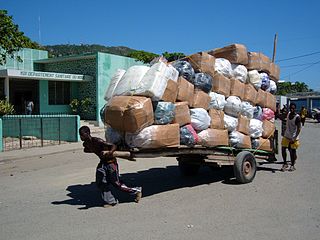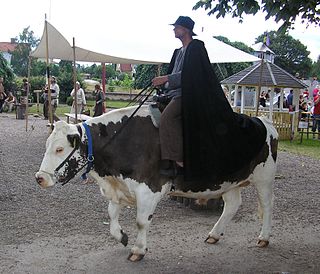
A cart or dray is a vehicle designed for transport, using two wheels and normally pulled by one or a pair of draught animals. A handcart is pulled or pushed by one or more people.

A coach is a bus used for longer-distance service, in contrast to transit buses that are typically used within a single metropolitan region. Often used for touring, intercity, and international bus service, coaches are also used for private charter for various purposes. Coaches are also related and fall under a specific category / specific type of RVs.

A carriage is a private four-wheeled vehicle for people and is most commonly horse-drawn. Second-hand private carriages were common public transport, the equivalent of modern cars used as taxis. Carriage suspensions are by leather strapping and, on those made in recent centuries, steel springs. Two-wheeled carriages are informal and usually owner-driven.

A wagon or waggon is a heavy four-wheeled vehicle pulled by draught animals or on occasion by humans, used for transporting goods, commodities, agricultural materials, supplies and sometimes people.

The hansom cab is a kind of horse-drawn carriage designed and patented in 1834 by Joseph Hansom, an architect from York. The vehicle was developed and tested by Hansom in Hinckley, Leicestershire, England. Originally called the Hansom safety cab, it was designed to combine speed with safety, with a low centre of gravity for safe cornering. Hansom's original design was modified by John Chapman and several others to improve its practicability, but retained Hansom's name.

A horse and buggy or horse and carriage refers to a light, simple, two-person carriage of the late 18th, 19th and early 20th centuries, drawn usually by one or sometimes by two horses. Also called a roadster or a trap, it was made with two wheels in England and the United States. It had a folding or falling top.
There are many types of car body styles. They vary depending on intended use, market position, location, and the era they were made in.

A phaeton was a form of sporty open carriage popular in the late eighteenth and early nineteenth century. Drawn by one or two horses, a phaeton typically featured a minimal very lightly sprung body atop four extravagantly large wheels. With open seating, it was both fast and dangerous, giving rise to its name, drawn from the mythical Phaëthon, son of Helios, who nearly set the Earth on fire while attempting to drive the chariot of the Sun.

A barouche is a large, open, four-wheeled carriage, both heavy and luxurious, drawn by two horses. It was fashionable throughout the 19th century. Its body provides seats for four passengers, two back-seat passengers vis-à-vis two behind the coachman's high box-seat. A leather roof can be raised to give back-seat passengers some protection from the weather.

A chaise, sometimes called chay or shay, is a light two- or four-wheeled traveling or pleasure carriage for one or two people with a folding hood or calash top. The name, in use in England before 1700, came from the French word "chaise" through a transference from a sedan-chair to a wheeled vehicle.
A gun carriage is a frame and mount that supports the gun barrel of an artillery piece, allowing it to be maneuvered and fired. These platforms often had wheels so that the artillery pieces could be moved more easily. Gun Carriages where also used on ships to facilitate the movement and aiming of large cannons.

A horse-drawn vehicle is a mechanized piece of equipment pulled by one horse or by a team of horses. These vehicles typically had two or four wheels and were used to carry passengers and/or a load. They were once common worldwide, but they have mostly been replaced by automobiles and other forms of self-propelled transport.

The chariot that evolved from the ancient vehicle of this name took on two main forms:

The Mossman Carriage Collection is a museum housing a collection of horse-drawn vehicles in Stockwood Park, Luton, Bedfordshire. It is the largest collection of such vehicles in the United Kingdom, and includes original vehicles dating from the 18th, 19th and 20th centuries.

Driving, when applied to horses, ponies, mules, or donkeys, is a broad term for hitching equines to a wagon, carriage, cart, sleigh, or other horse-drawn vehicle by means of a harness and working them in this way. It encompasses a wide range of activities from pleasure driving, to harness racing, to farm work, horse shows, and even international combined driving.

A coach is a large closed four-wheeled passenger-carrying vehicle or carriage usually drawn by two or more horses usually controlled by a coachman, a postilion, or occasionally both. A coach has doors in its sides and a front and a back seat inside. The driver has a seat in front raised up high to give good vision. It is often called a box, box seat or coach box. The word coach came into use in the 15th century and spread across Europe. There are a number of types of coaches depending on how the vehicle is to be used. In India it is called a Rath or रथ. Special breeds of horses, such as the now-extinct Yorkshire Coach Horse, were developed to pull the heavy coaches.

A cabriolet is a light horse-drawn vehicle, with two wheels and a single horse. The carriage has a folding hood that can cover its two occupants, one of whom is the driver. It has a large rigid apron, upward-curving shafts, and usually a rear platform between the C springs for a groom. The design was developed in France in the eighteenth century and quickly replaced the heavier hackney carriage as the vehicle for hire of choice in Paris and London.

Breeching ( "britching") is a strap around the haunches of a draft, pack or riding animal. Both under saddle and in harness, breeching engages when an animal slows down or travels downhill and is used to brake or stabilize a load.

The Horseshoe Barn and Horseshoe Barn Annex are two exhibit buildings located at Shelburne Museum in Shelburne, Vermont. Both buildings exhibit a variety of horse-drawn vehicles, including carriages, trade wagons, stagecoaches, and sleighs.

The following outline is provided as an overview of and topical guide to animal-powered transport:




















